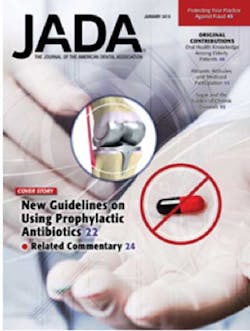In the Introduction of the last issue (December 5, 2014) I mentioned a Lancet study on antibiotic prophylaxis and infective endocarditis (IE). The study was published online November 18, 2014, and stated a gradual increase in the incidence of IE in England.(1) This increased incidence seems to parallel a reduction in antibiotic prophylaxis for IE prevention. This article will discuss these guidelines as well as newguidelines for prosthetic joints.
The January issue of The Journal of the American Dental Association will feature updated ADA guidelines about the indication for antibiotic prophylaxis before dental treatment in patients with prosthetic joints.(6) A 2014 panel of experts, tasked by the ADA Council on Scientific Affairs, developed the ADA guidelines, "The Use of Prophylactic Antibiotics Prior to Dental Procedures in Patients with Prosthetic Joints: Evidence-Based Clinical Practice Guideline for Dental Practitioners."
This panel updated the systematic review that was the base of "Prevention of Orthopaedic Implant Infection in Patients Undergoing Dental Procedures Evidence-Based Guideline and Evidence Report," which a 2012 panel of American Academy of Orthopaedic Surgeons and ADA authors co-developed.(7) Dentists should be aware that there does not appear to be conflict between the updated ADA prosthetic joint infection guideline and a recent Lancet publication on infective endocarditis.
Be sure to read the January issue of The Journal of the American Dental Association!
References
1. "Incidence of Infective Endocarditis in England, 2000–13: a Secular Trend, Interrupted Time–Series Analysis."
2. Prevention of Infective Endocarditis: Guidelines From the American Heart Association. Circulation. 2007;116:1736-1754. http://circ.ahajournals.org/content/116/15/1736.full.pdf.
3. Strom BL, Abrutyn E, Berlin JA, Kinman JL, Feldman RS, Stolley PD, Levison ME, Korzeniowski OM, Kaye D. Dental and cardiac risk factors for infective endocarditis: a population-based, case-control study. Ann Intern Med. 1998;129: 761–769.
4. Durack DT. Antibiotics for prevention of endocarditis during dentistry: time to scale back? Ann Intern Med. 1998;129: 829 – 831.
5. Lockhart PB, Brennan MT, Fox PC, Norton HJ, Jernigan DB, Strausbaugh LJ. Decision-making on the use of antimicrobial prophylaxis for dental procedures: a survey of infectious disease consultants and review. Clin Infect Dis. 2002; 34: 1621–1626.
6. ADA News. New guidelines addressing antibiotics and prosthetic joints in January JADA. December 03, 2014. http://www.ada.org/en/publications/ada-news/2014-archive/december/new-guidelines-addressing-antibiotics-and-prosthetic-joints-in-january-jada.
7. AAOS and ADA. Prevention of Orthopaedic Implant Infection In Patients Undergoing Dental Procedures Evidence-Based Guideline And Evidence Report. http://www.ada.org/~/media/ADA/Member%20Center/FIles/PUDP_guideline.ashx.










